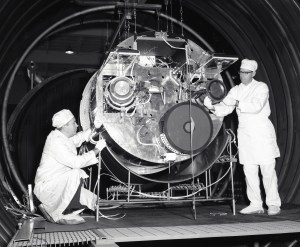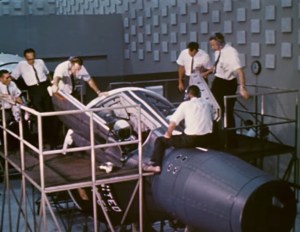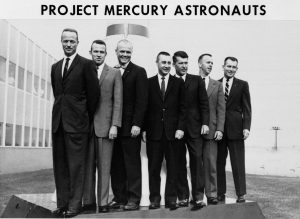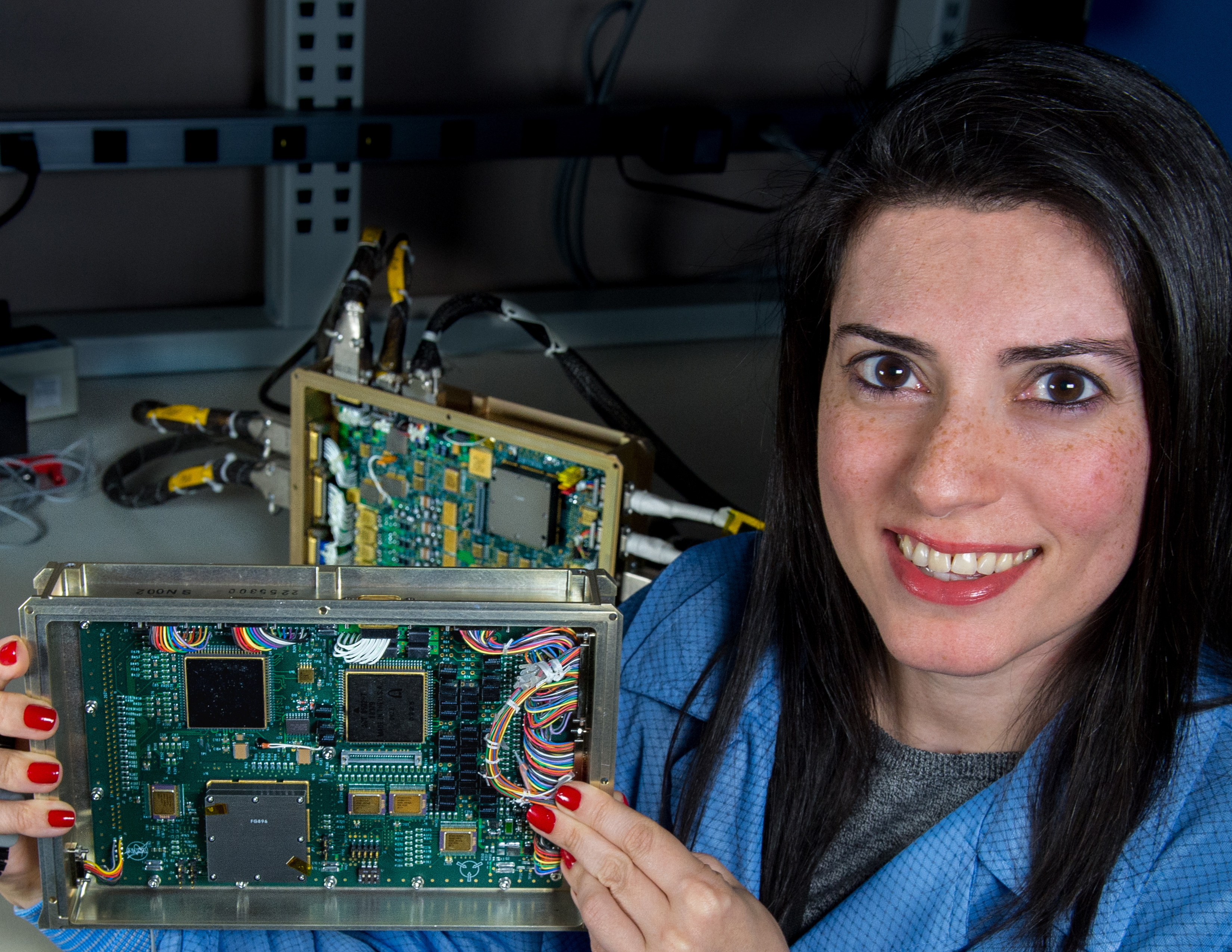45 Years Ago: Space Shuttle Enterprise Arrives at NASA’s Kennedy Space Center
Enterprise, the first space shuttle orbiter that NASA built, arrived at NASA’s Kennedy Space Center (KSC) in Florida on April 10, 1979. Although not space worthy, as a pathfinder Enterprise carried out tasks critical to ensuring the success of the space shuttle program. During its four-month stay at KSC, Enterprise validated procedures for the assembly […]
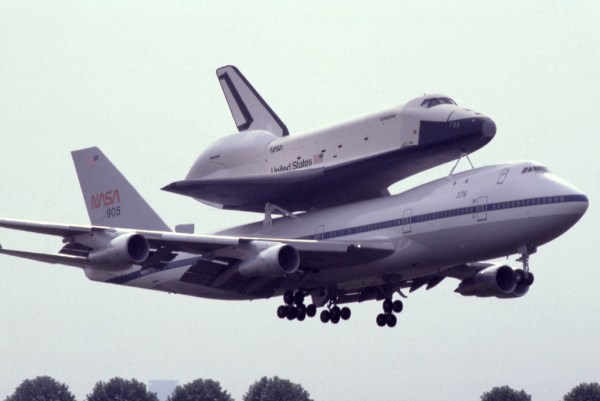
Enterprise, the first space shuttle orbiter that NASA built, arrived at NASA’s Kennedy Space Center (KSC) in Florida on April 10, 1979. Although not space worthy, as a pathfinder Enterprise carried out tasks critical to ensuring the success of the space shuttle program. During its four-month stay at KSC, Enterprise validated procedures for the assembly of the space shuttle stack and interfaces at the launch pad. The tests proved valuable in preparing the shuttle for its first orbital mission. Earlier, Enterprise proved the flight worthiness of the shuttle during atmospheric tests and certified the vehicle’s structure to handle launch loads. Enterprise played small supporting roles in the Challenger and Columbia accident investigations. After a lengthy stay in storage, a fully restored Enterprise went on public display, first near Washington, D.C., and then in New York where it currently resides.
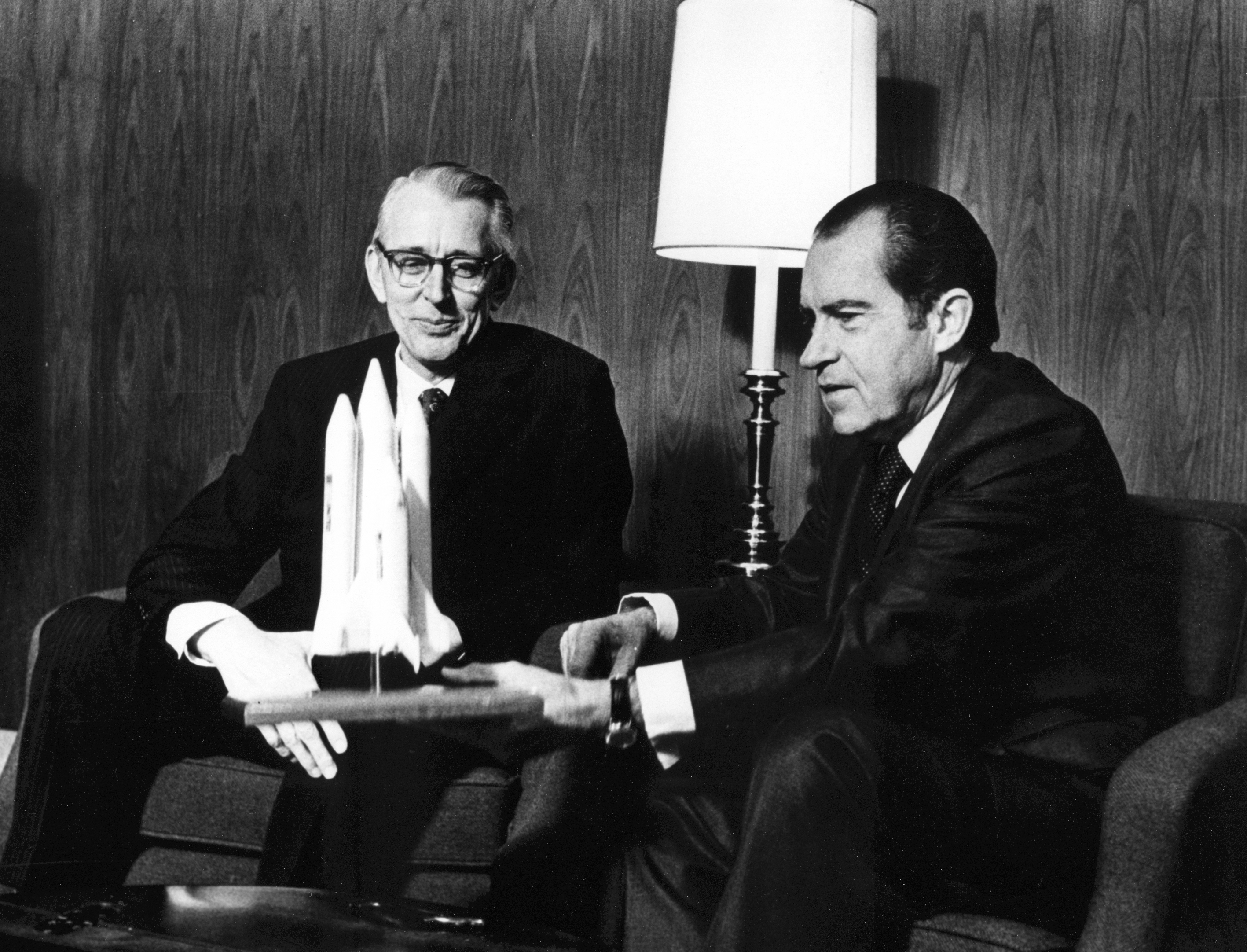
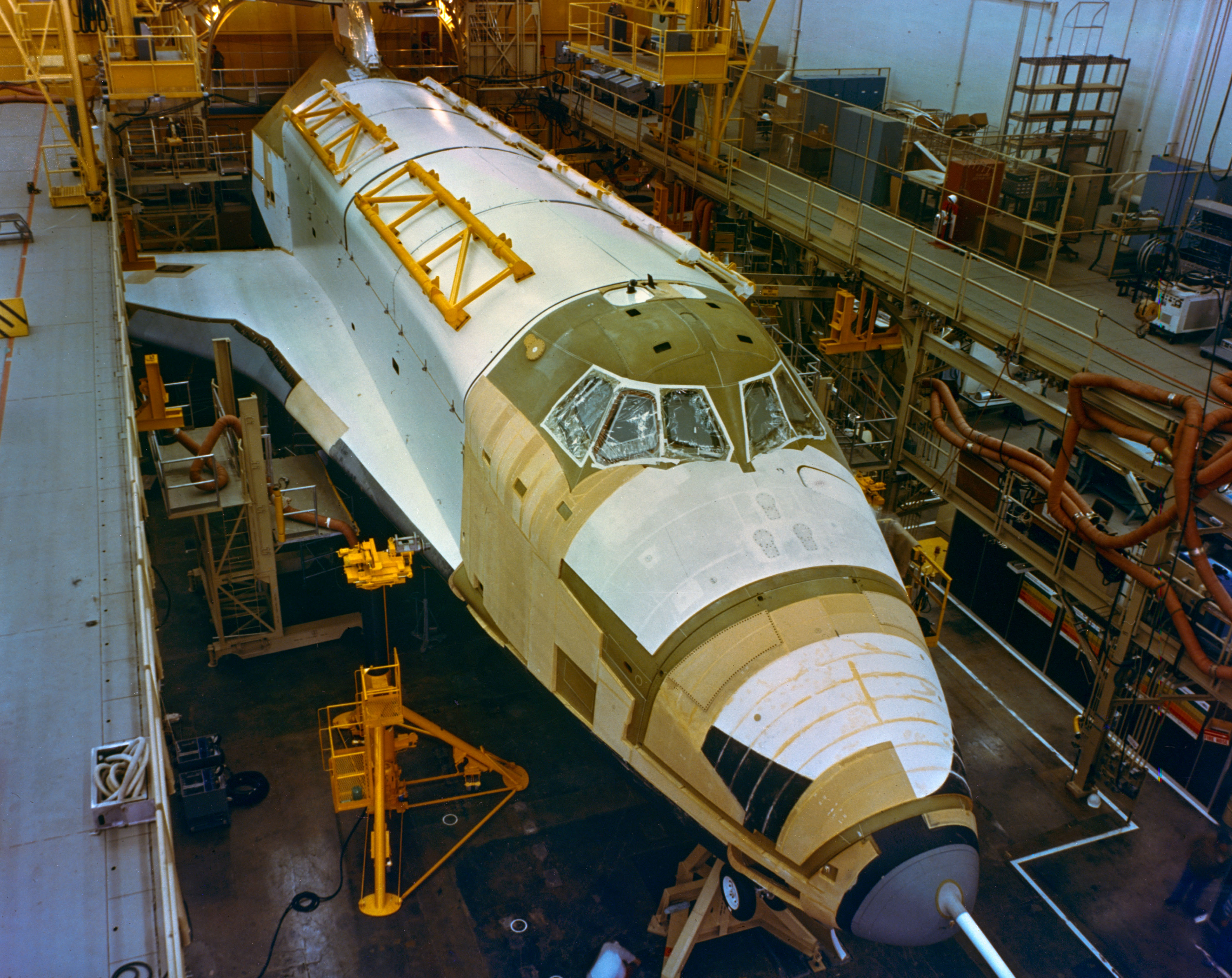
Left: NASA Administrator James C. Fletcher, left, presents President Richard M. Nixon with a model of the space shuttle in January 1972. Right: Enterprise under construction in 1976.
Enterprise’s story began on Jan. 5, 1972, when President Richard M. Nixon directed NASA to build the reusable space shuttle, formally called the Space Transportation System (STS), stating that “it would revolutionize transportation into near space.” NASA Administrator James C. Fletcher hailed the President’s decision as “an historic step in the nation’s space program,” adding that it would change what humans can accomplish in space. After Congress authorized the funds, on July 26 NASA awarded the contract to the North American Rockwell Corporation of Downey, California, to begin construction of the first vehicles. Manufacture of the first components of Orbital Vehicle-101 (OV-101) at Rockwell’s Downey plant began on June 4, 1974.
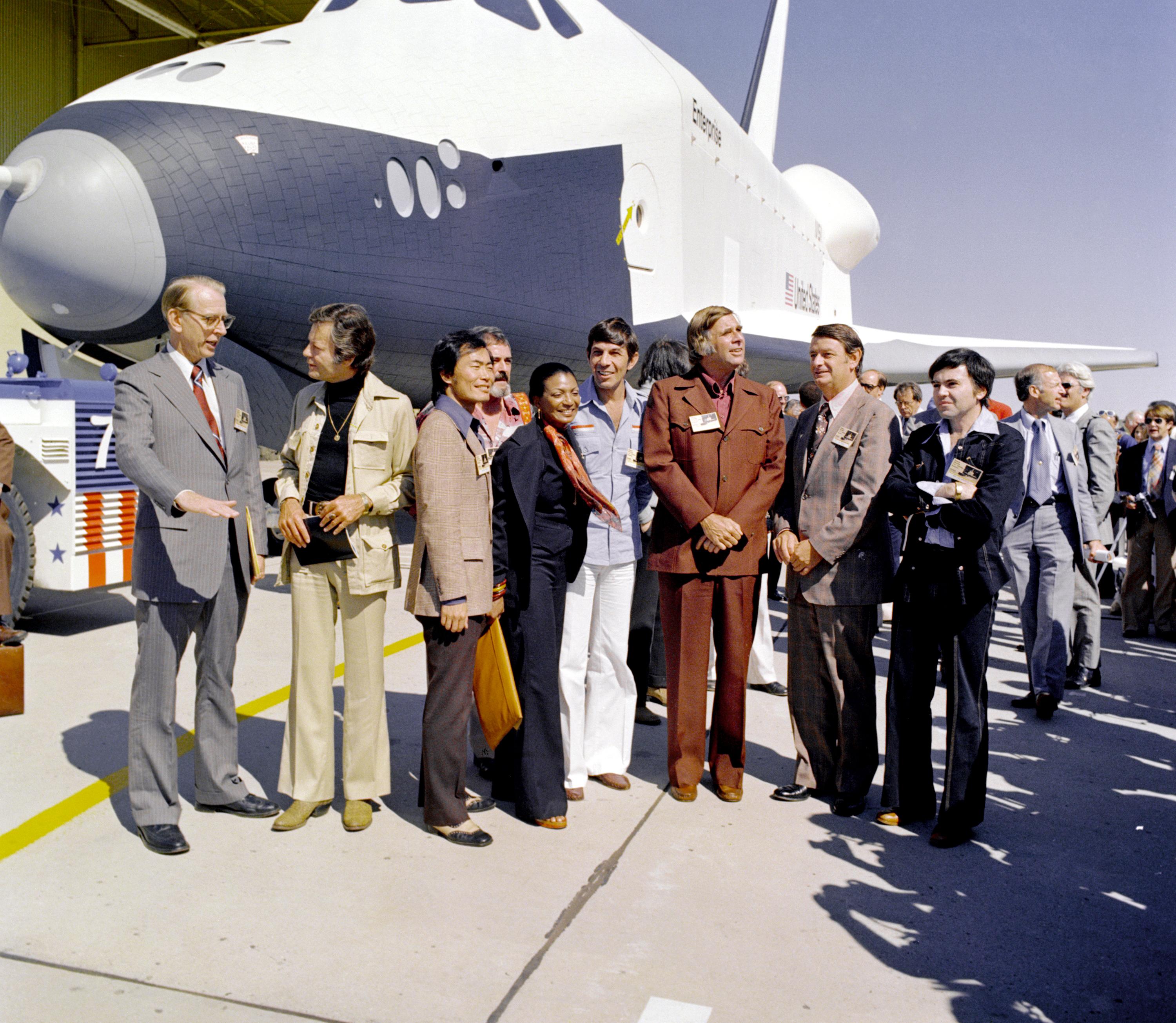
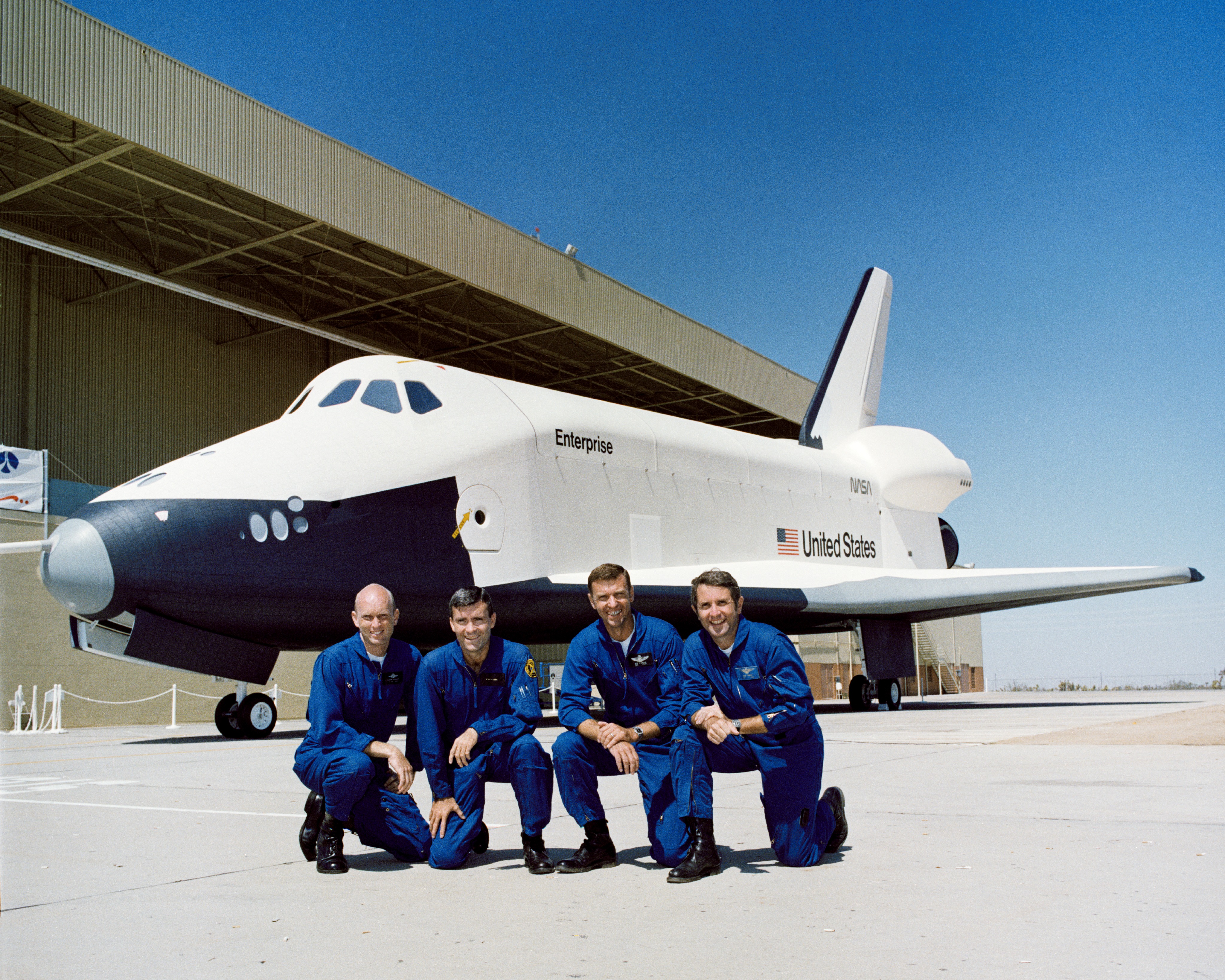
Left: NASA Administrator James C. Fletcher, left, poses with several cast members and creator of the TV series “Star Trek” at Enterprise’s rollout. Right: Astronauts C. Gordon Fullerton, left, Fred W. Haise, Joe H. Engle, and Richard H. Truly pose in front of Enterprise on the day of its rollout.
NASA originally chose the name Constitution for OV-101, the first space shuttle vehicle designed not to fly in space but for ground and atmospheric tests. However, a determined write-in campaign by fans of the science fiction TV series “Star Trek” convinced NASA to rename this first vehicle Enterprise, after the fictional starship made famous by the show. When the orbiter made its public rollout at Rockwell’s Palmdale, California, facility, on Sept. 17, 1976, it bore the name Enterprise. Several “Star Trek” cast members as well as the show’s creator attended the event, accompanied by NASA Administrator Fletcher and the four astronauts assigned to conduct the Approach and Landing Tests (ALT) with Enterprise– Fred W. Haise, C. Gordon Fullerton, Joe H. Engle, and Richard H. Truly.
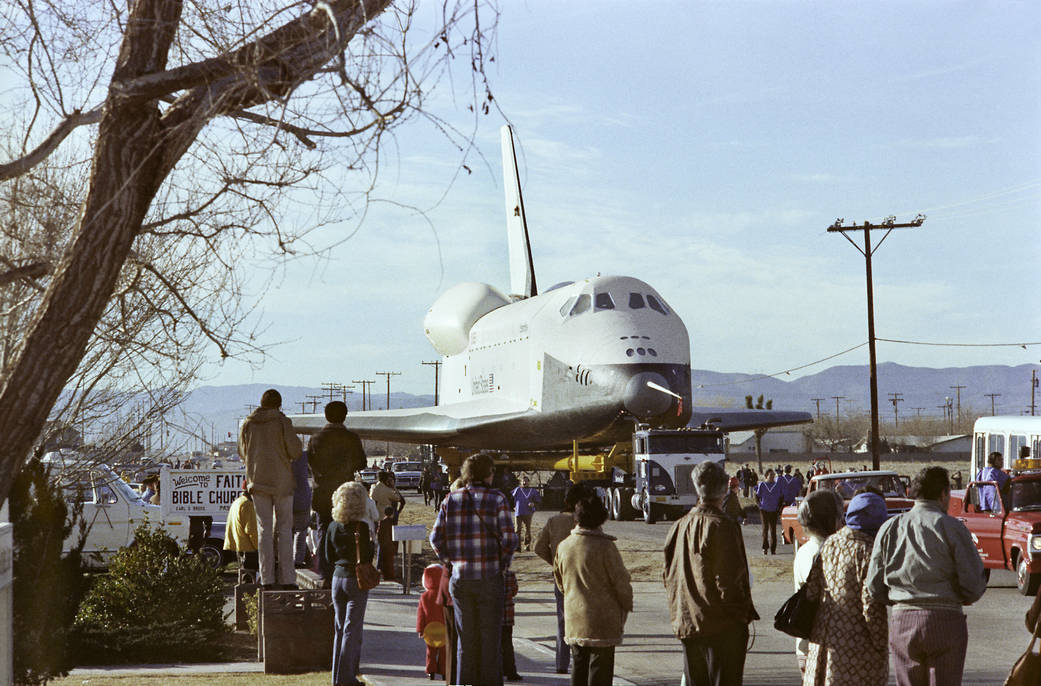
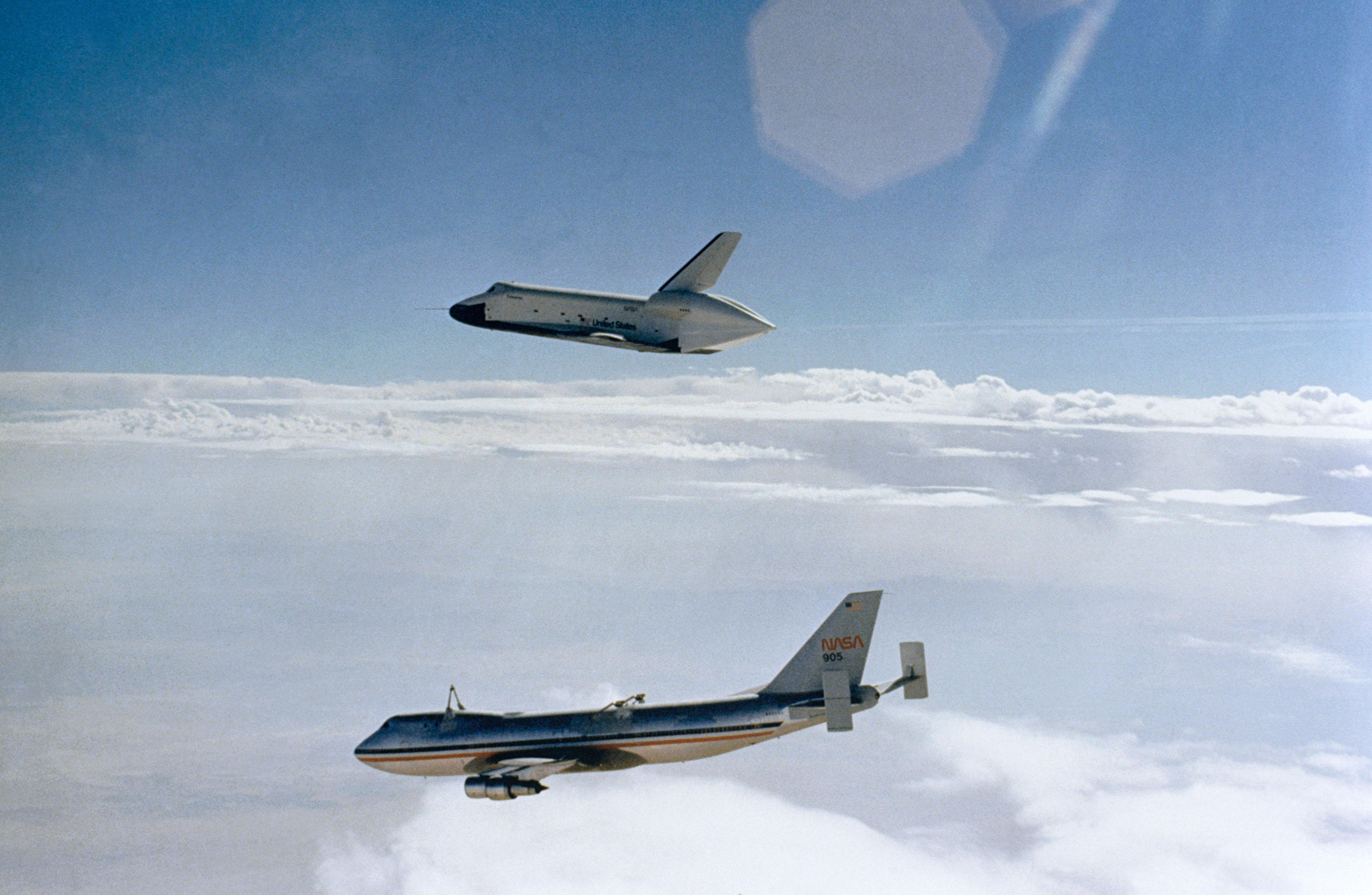
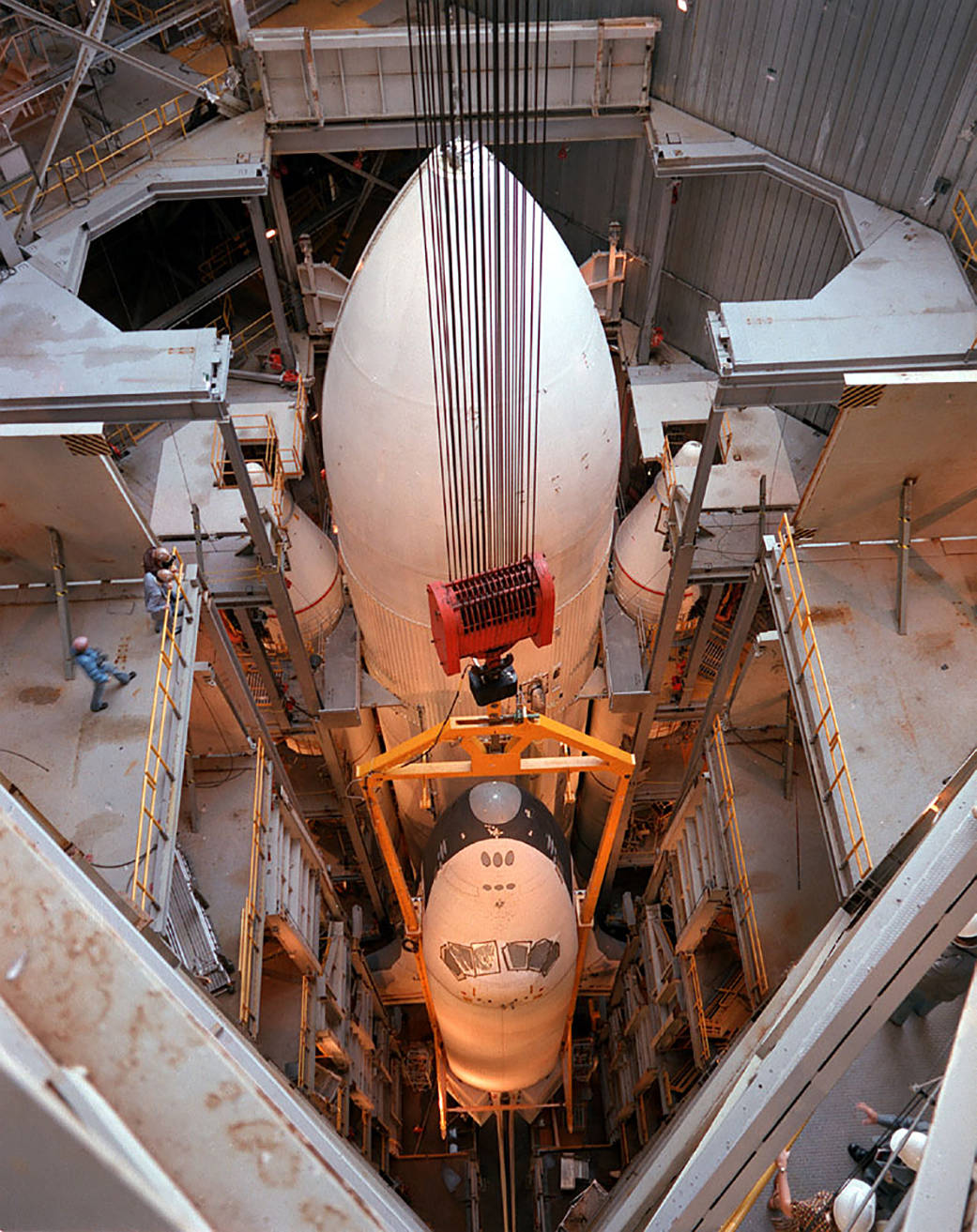
Left: Workers tow space shuttle Enterprise through the streets of Lancaster, California, on the way to NASA’s Dryden, now Armstrong, Flight Research Center at Edwards Air Force Base. Middle: Enterprise moments after release from the back of the Shuttle Carrier Aircraft during the first Approach and Landing Test free flight. Right: At NASA’s Marshall Space Flight Center in Huntsville, Alabama, for vibration tests, a shuttle orbiter joins an External Tank and twin Solid Rocket Boosters for the first time.
In January 1977, workers trucked Enterprise 36 miles overland from Palmdale to NASA’s Dryden, now Armstrong, Flight Research Center at Edwards Air Force Base (AFB) in California, for the ALT program, a series of increasingly complex flights to evaluate the shuttle’s air worthiness. At Dryden, workers placed Enterprise on the back of the Shuttle Carrier Aircraft (SCA), a modified Boeing 747. The duo began taxi runs in February, followed by the first captive inactive flight later that month. The first captive active flight with a crew aboard the orbiter took place in June, and Enterprise made its first independent flight on Aug. 12 with Haise and Fullerton at the controls. Four additional approach and landing flights completed the ALT program by October. In March 1978, Enterprise began its first cross-country trip. Riding atop the SCA, Enterprise left Edwards, and after a weekend stopover at Houston’s Ellington AFB, arrived at the Redstone Arsenal’s airfield in Huntsville, Alabama. Workers trucked Enterprise to the adjacent NASA Marshall Space Flight Center where engineers for the first time mated it with an External Tank (ET) and inert Solid Rocket Boosters (SRB) in the Dynamic Structural Test Facility. For the next year, engineers conducted a series of vibration tests on the combined vehicle, simulating conditions expected during an actual launch.


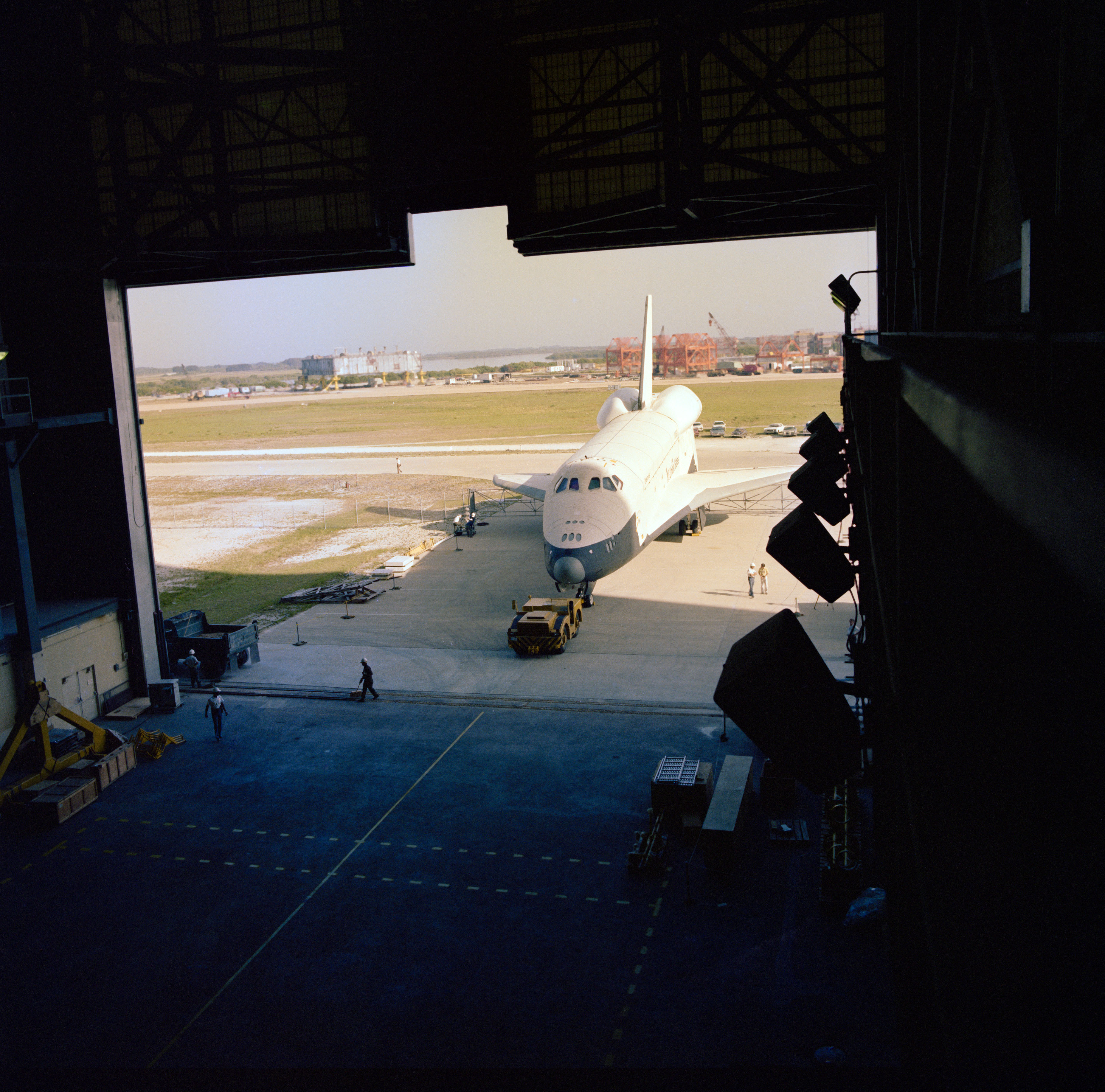
Left: Enterprise atop its Shuttle Carrier Aircraft (SCA) touches down on the runway at NASA’s Kennedy Space Center in Florida. Middle: Workers remove Enterprise from the SCA in the Mate-Demate Device. Right: Workers tow Enterprise into the Vehicle Assembly Building.
Following the year-long series of tests at Marshall, on April 10, 1979, NASA ferried Enterprise atop its SCA to KSC. Its sister ship Columbia, the first shuttle destined for orbital flight, had arrived there just two weeks earlier. The SCA/Enterprise vehicle remained on display at the Shuttle Landing Facility (SLF) for five days to give more than 75,000 KSC employees, their families, and the general public a chance to view the new reusable spacecraft. Workers at the SLF then removed the orbiter from the back of the SCA in the Mate-Demate Device, and towed it into High Bay 3 of the Vehicle Assembly Building (VAB) where on April 25 they completed attaching it to an ET and inert SRBs on a Mobile Launch Platform (MLP) repurposed from carrying Saturn rockets. These activities enabled verification of towing, assembly, and checkout procedures.
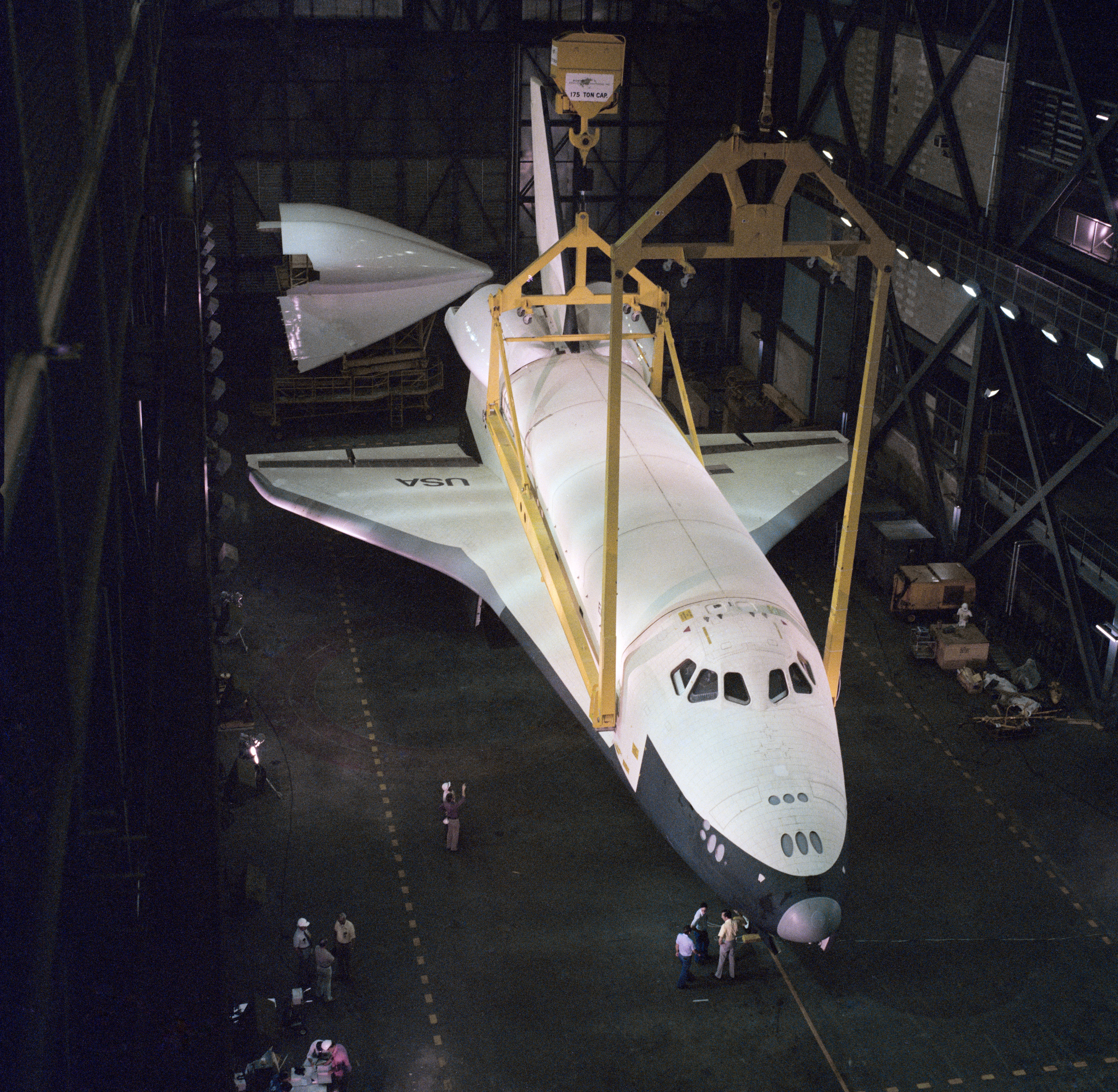
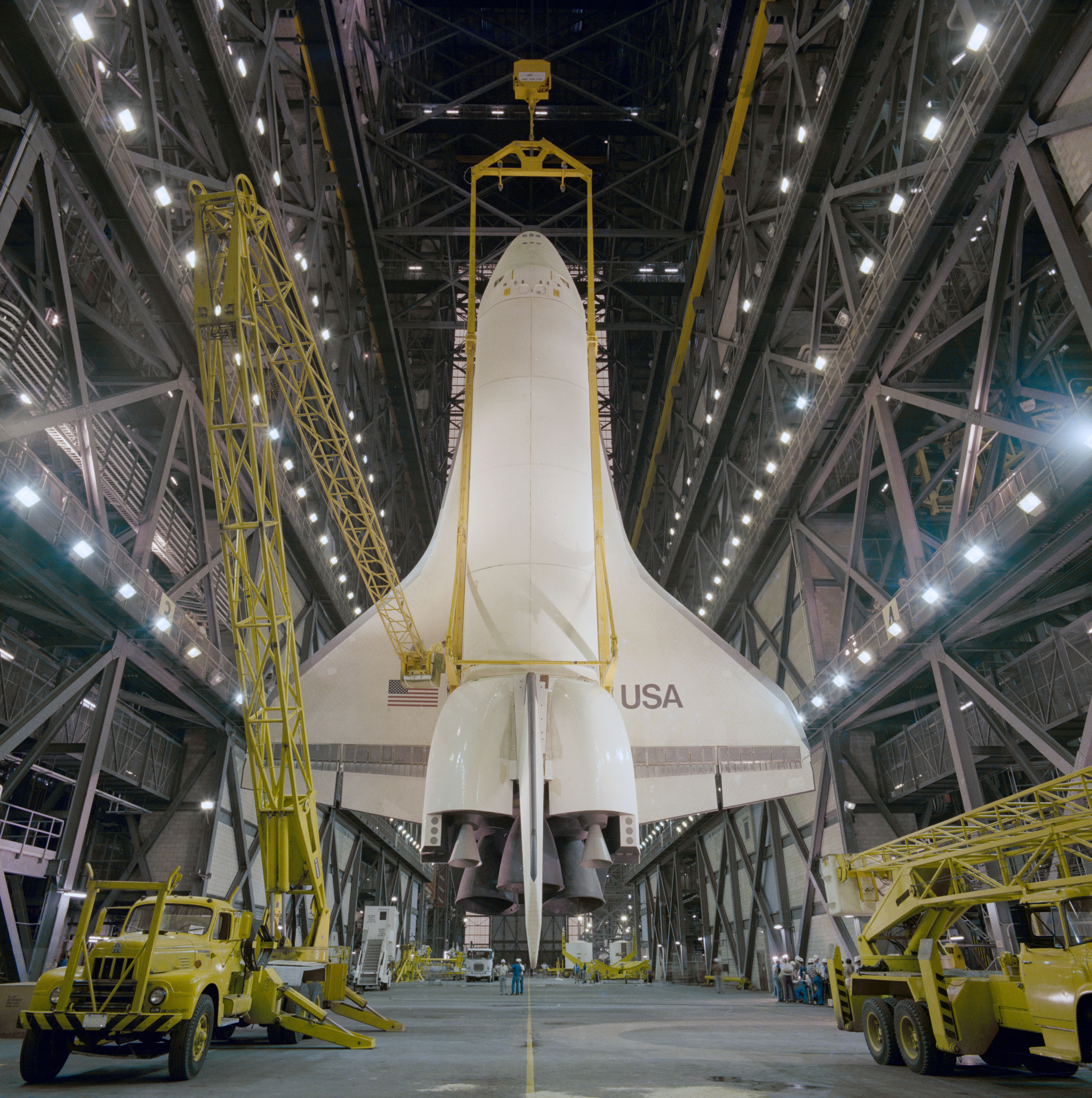
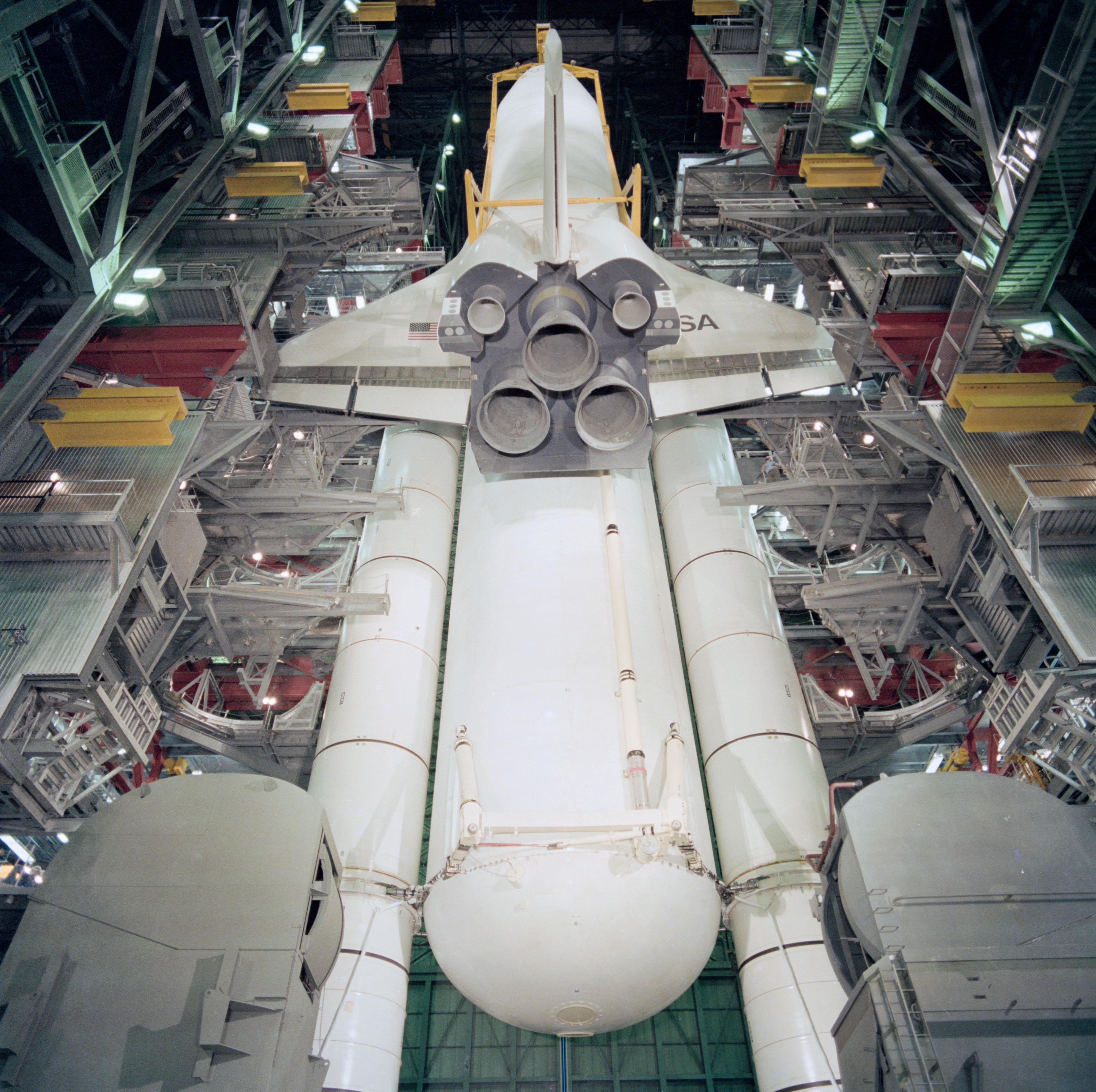
Left: At NASA’s Kennedy Space Center in Florida, workers in the Vehicle Assembly Building prepare to lift Enterprise. Middle: Enterprise in the vertical position. Right: Workers lower Enterprise for attachment to the External Tank and Solid Rocket Boosters.
Rollout of Enterprise from the VAB to Launch Pad 39A occurred on May 1, and again KSC employees and their families came out to view the event. The assembled vehicle including the MLP weighed about 11 million pounds. Technicians drove the stack atop the Crawler Transporter at varying speeds to determine the optimum velocity to minimize vibration stress on the vehicle. The 3.5-mile rollout took about eight hours to complete. Once at the pad, engineers used Enterprise to conduct fit checks and to validate launch pad procedures. During the critical countdown demonstration test, workers filled the ET with super-cold liquid hydrogen and liquid oxygen. The significant discovery that ice built up at the top of the ET during this process led to the addition of the gaseous oxygen vent hood (familiarly known as the “beanie cap”) to the launch pad facility and a procedure to retract it just a few minutes before liftoff. This prevented the dangerous buildup of ice during the countdown and ranks as perhaps one of Enterprise’s greatest contributions as a test vehicle during its time at the launch pad.
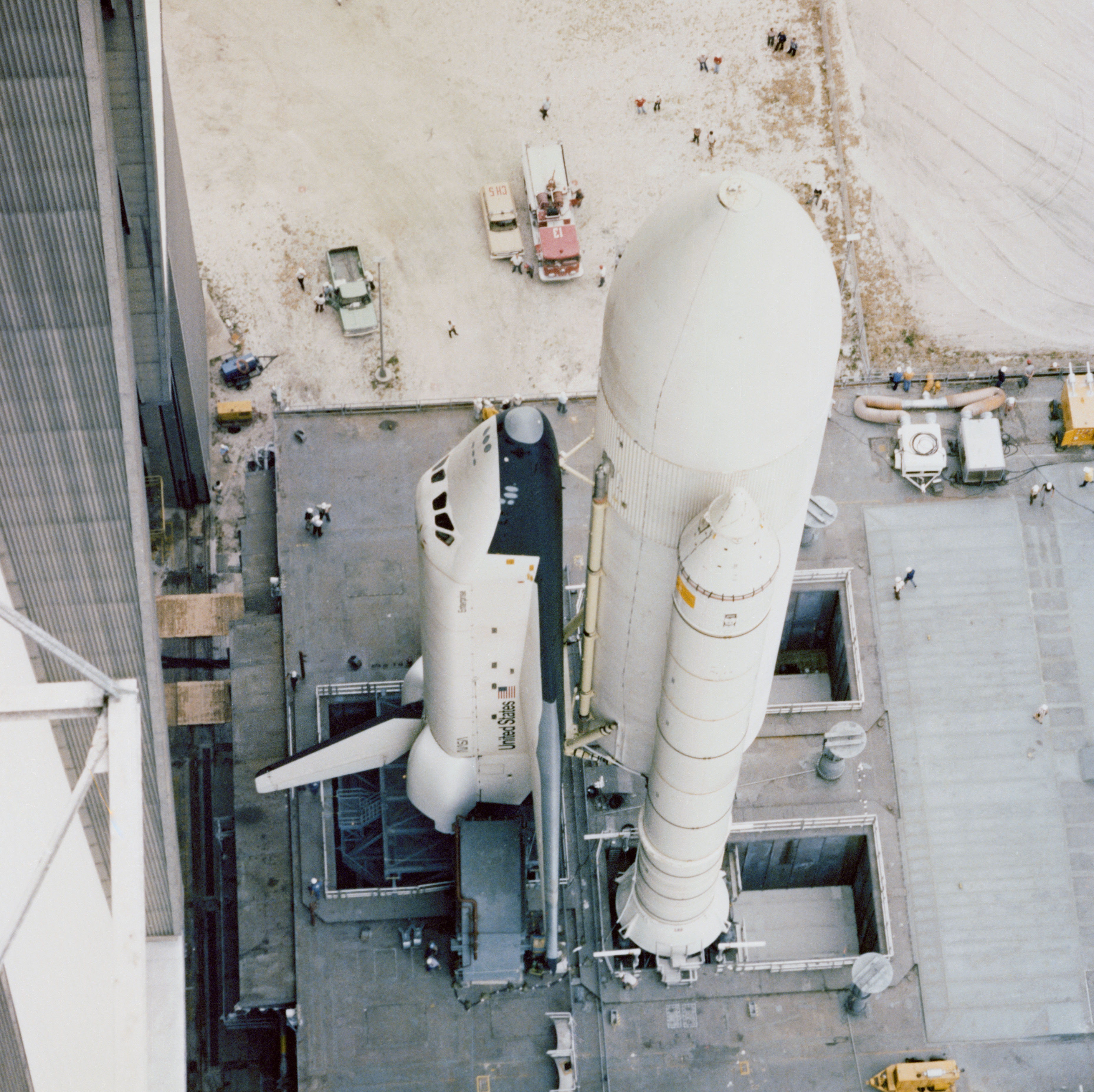
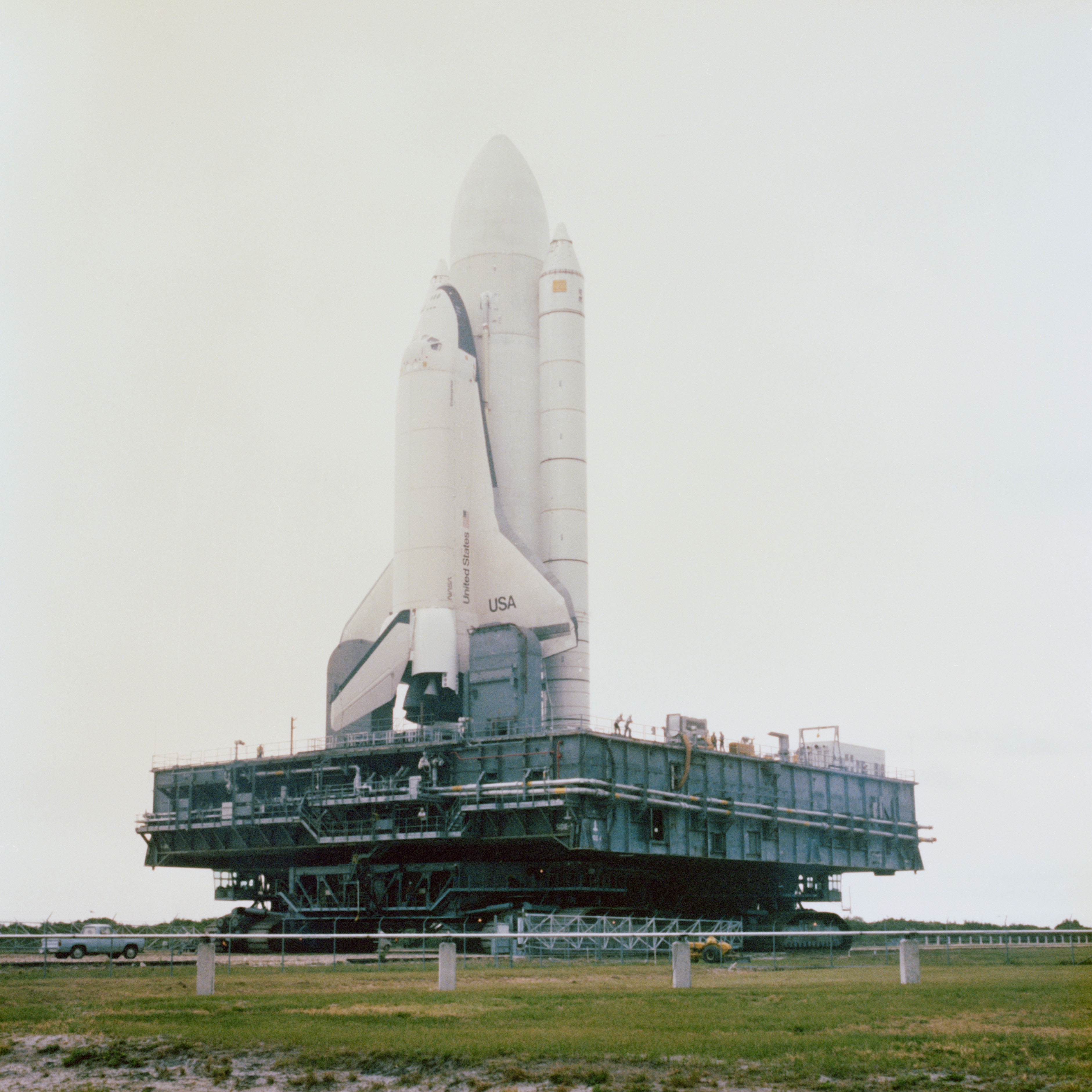
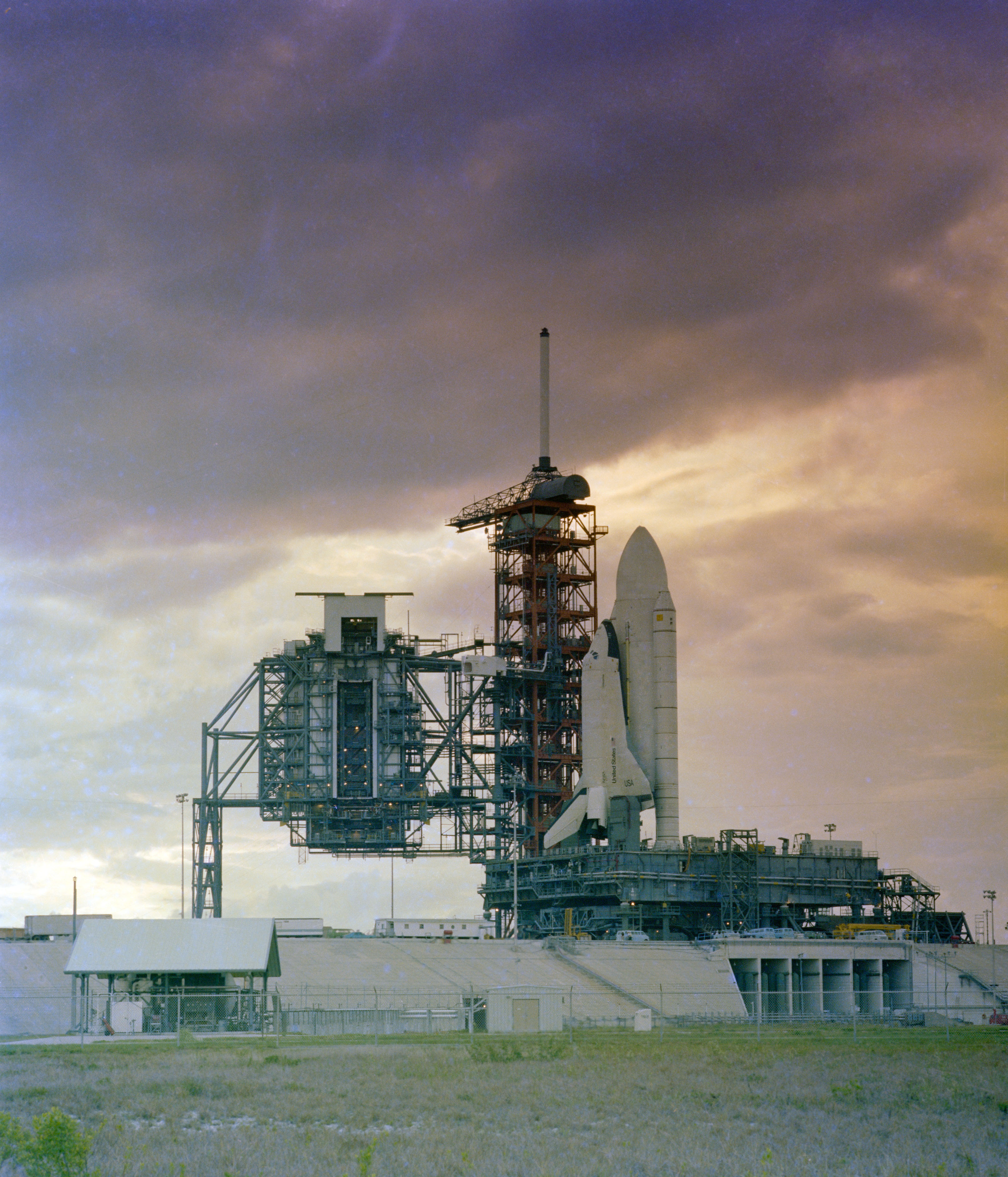
Left: Enterprise exiting the Vehicle Assembly Building. Middle: Enterprise on its Mobile Launch Platform during the rollout to the pad. Right: Enterprise at Launch Pad 39A.
On July 23, after three months of fit checks and testing, workers rolled Enterprise back from Launch Pad 39A to High Bay 1 in the VAB. The activities conducted at the pad proved instrumental in paving the way for its sister ship Columbia to make its first launch in 1981. John Bell, who managed the activities at JSC said of the test program, “Overall, it was a very successful venture and well worth it.” Launch Pad 39A Site Manager John J. “Tip” Talone added, “Having [Enterprise] out here really saved the program a lot of time in getting things ready for [Columbia].” In the VAB, workers removed Enterprise from its ET on July 25 and towed it to the SLF on Aug. 3 where it awaited the arrival of the SCA. The ferry flight back to Dryden took place between Aug. 10 and 16 making six stops along the way – Atlanta, St. Louis, Tulsa, Denver, Salt Lake City, and Vandenberg AFB in California. Up to 750,000 people came out to see the orbiter and SCA. Back at Dryden, workers demated Enterprise and on Oct. 30 trucked it back to the Palmdale plant where engineers removed computers and instruments to be refurbished and used in other orbiters then under construction. Previous plans to convert Enterprise into an orbital vehicle proved too costly and NASA abandoned the idea.
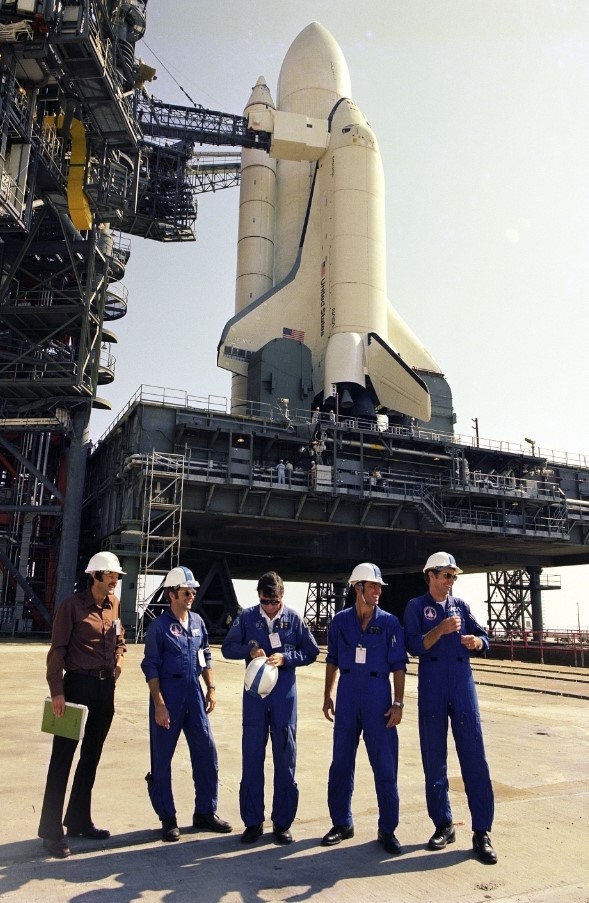
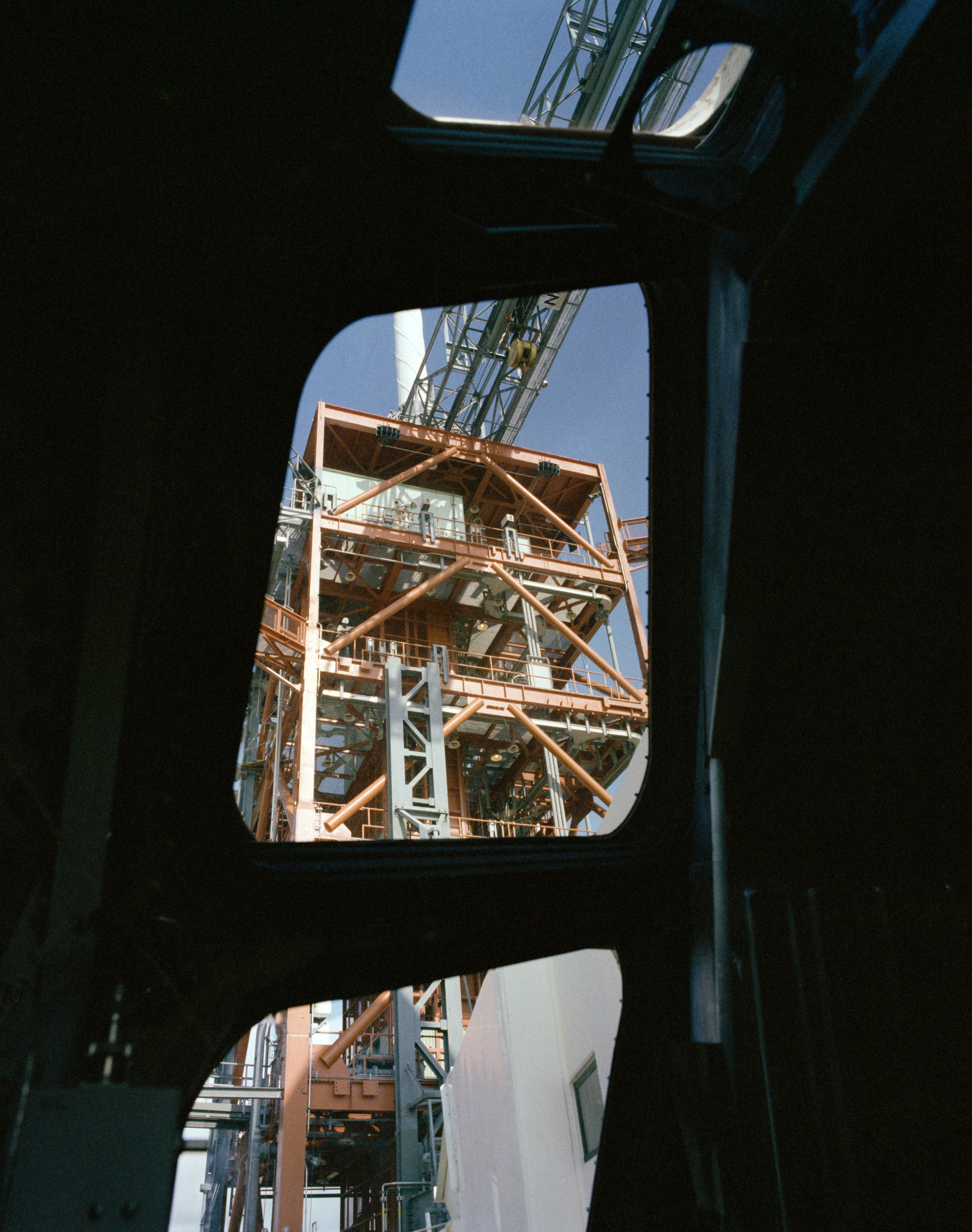
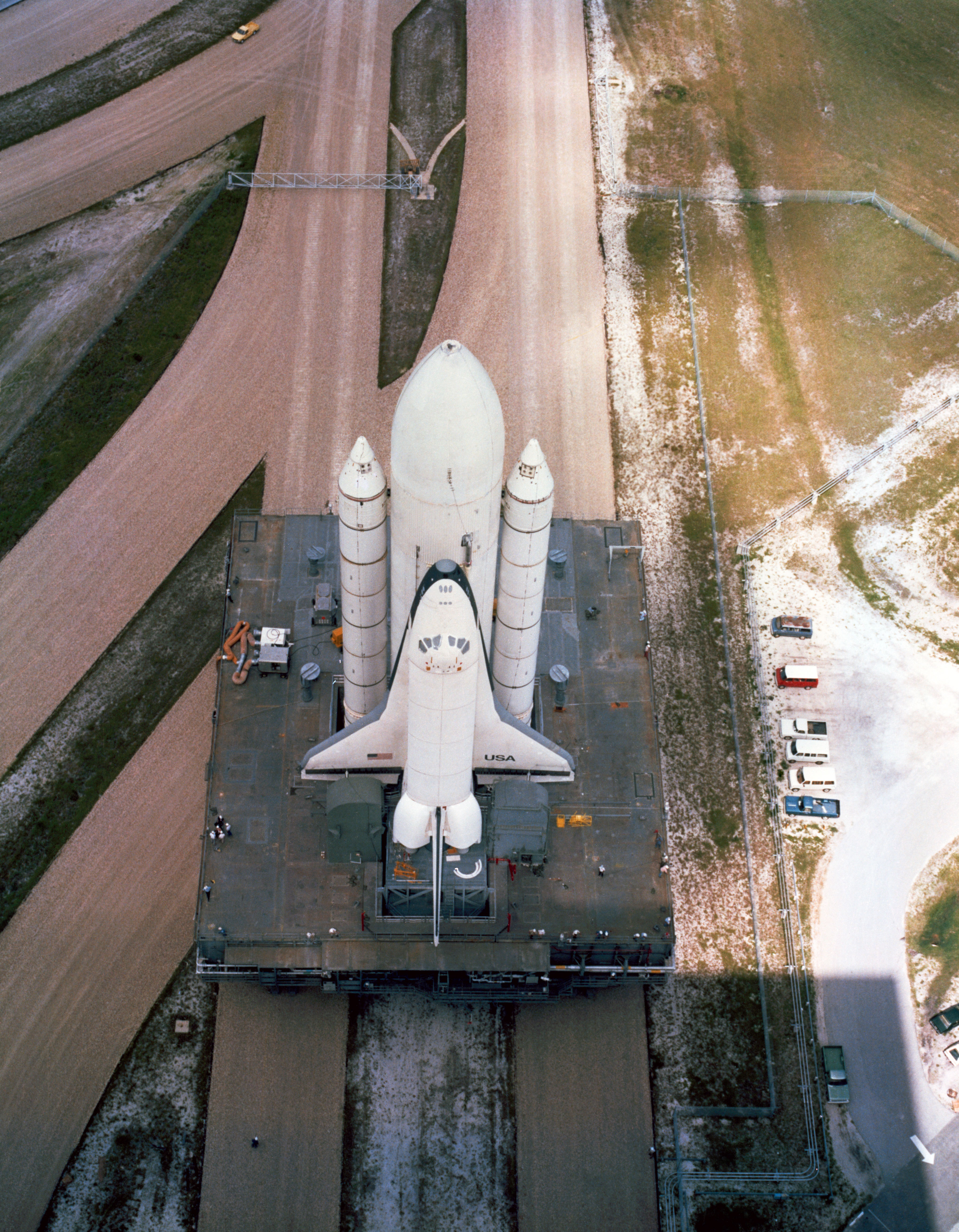
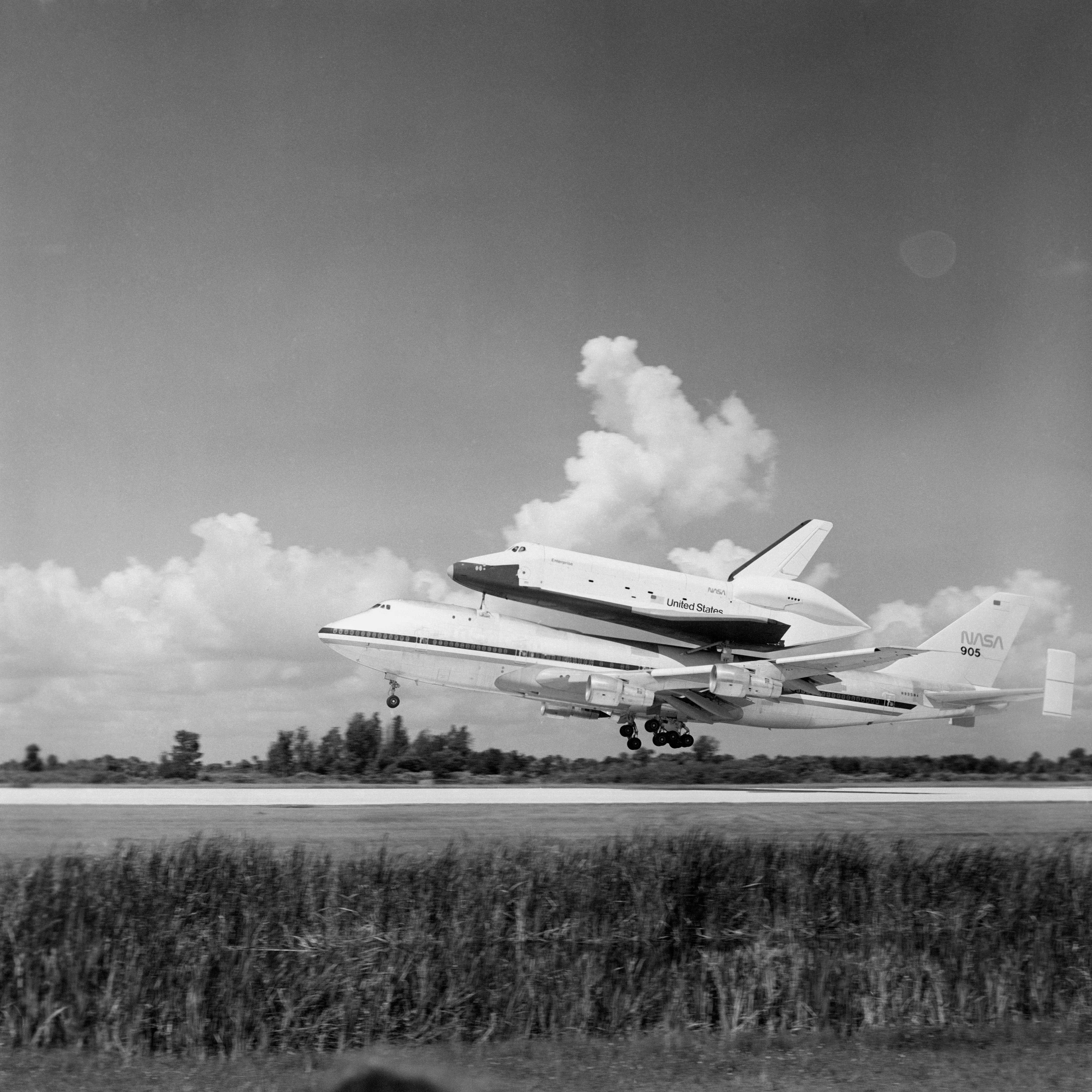
Left: Astronaut support engineer Richard W. Nygren stands at Launch Pad 39A with astronauts Richard H. Truly, John W. Young, Robert L. Crippen, and Joe H. Engle, the prime and backup crews assigned to the first space shuttle mission. Middle left: Pilot’s eye view of the launch tower looking up through Enterprise’s forward windows. Middle right: Enterprise rolls back into the Vehicle Assembly Building. Right: Enterprise departs NASA’s Kennedy Space Center in Florida atop the Shuttle Carrier Aircraft.
Because Enterprise’s future remained uncertain, NASA returned it to Edwards on Sep. 6, 1981, for long-term storage. On July 4, 1982, NASA used it as a backdrop for President Ronald W. Reagan to welcome home the STS-4 crew. The following year, NASA sent Enterprise on a European tour, departing Dryden on May 13, 1983, with stops in the United Kingdom, Germany, Italy, and France for the annual Paris Air Show. Enterprise made a stop in Ottawa, Canada, on its return trip to Dryden, arriving there June 13. Workers once again placed it in temporary storage.
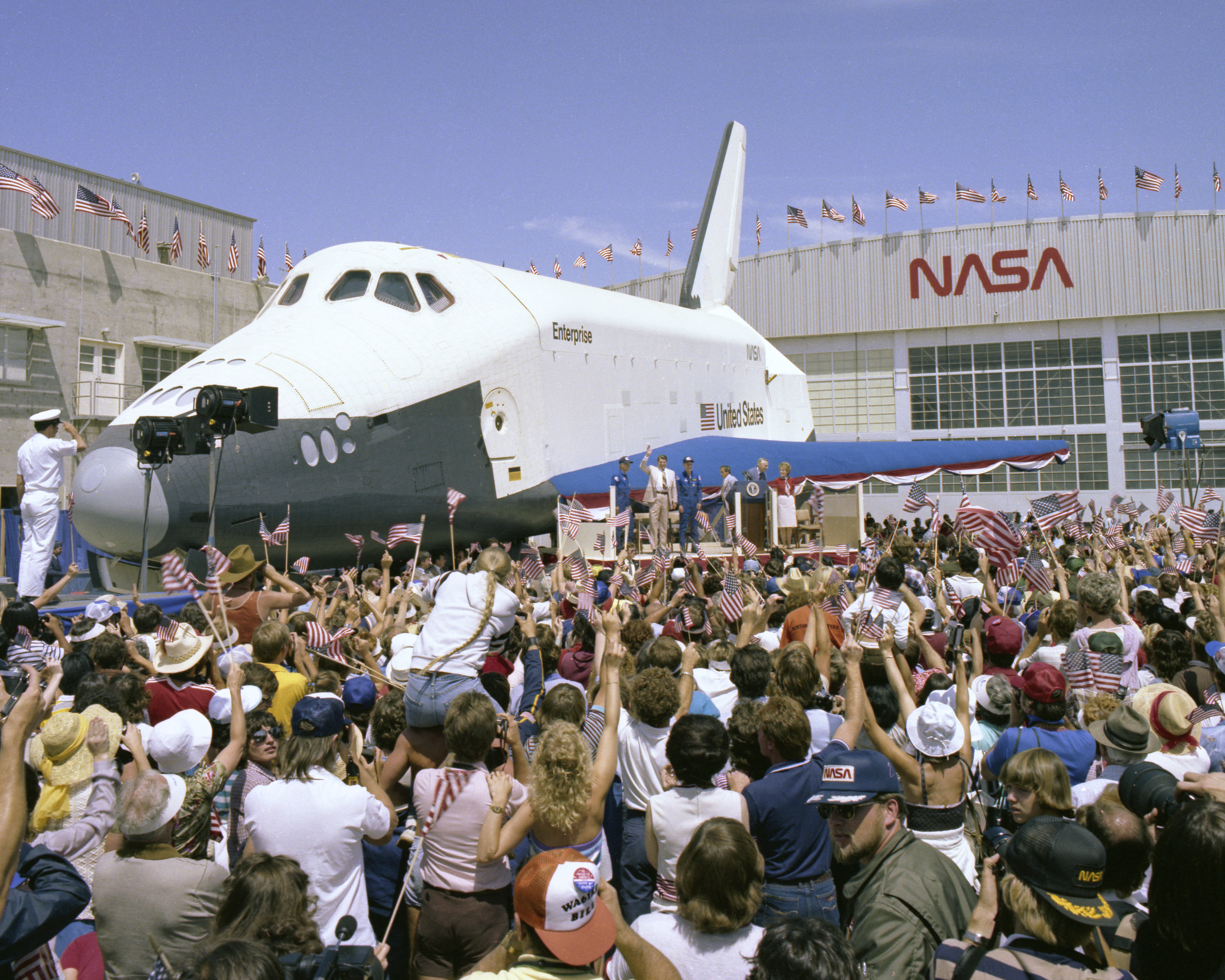
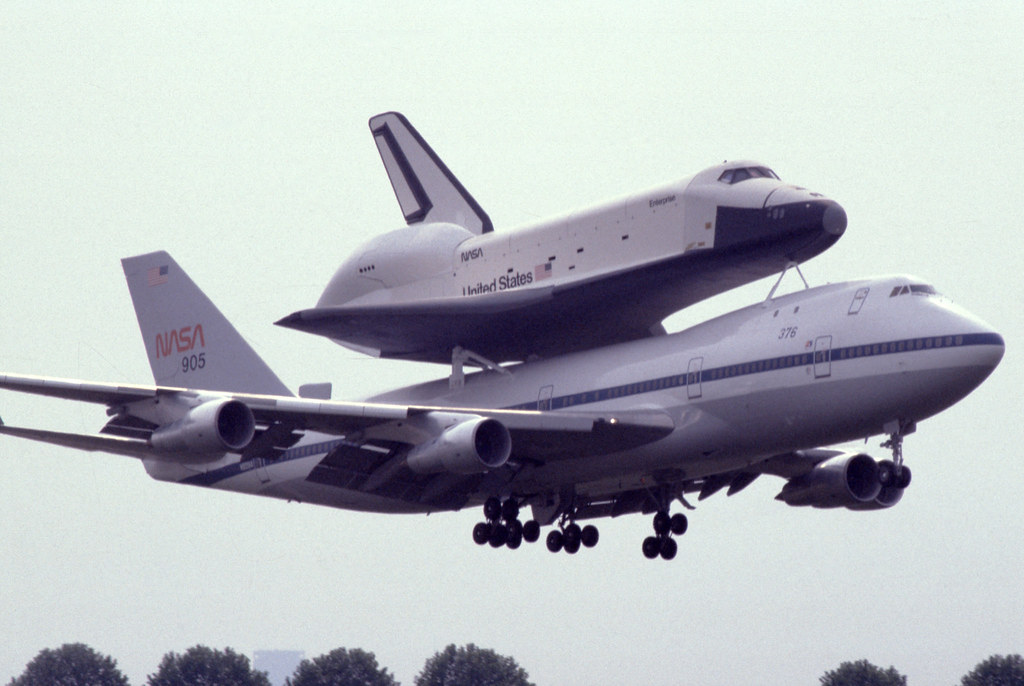
Left: Enterprise as the backdrop for President Reagan welcoming home the STS-4 crew at NASA’s Dryden, now Armstrong, Flight Research Center in July 1982. Right: Enterprise atop the Shuttle Carrier Aircraft arriving at the Paris Air Show in May 1983.
For its next public appearance, NASA ferried Enterprise to Mobile, Alabama, from there transported it by barge to New Orleans, and placed it on public display in the U.S. pavilion of the World’s Fair between April and November 1984. After the World’s Fair, NASA ferried Enterprise to Vandenberg AFB in California to conduct fit checks at the Space Launch Complex-6 (SLC-6), that NASA had planned to use for polar orbiting shuttle missions. NASA used Enterprise to conduct tests at SLC-6 similar to the 1979 tests at KSC’s Launch Complex 39. The tests at Vandenberg completed, NASA ferried Enterprise back to Dryden on May 24, 1985, but this time for only a very short-term storage.
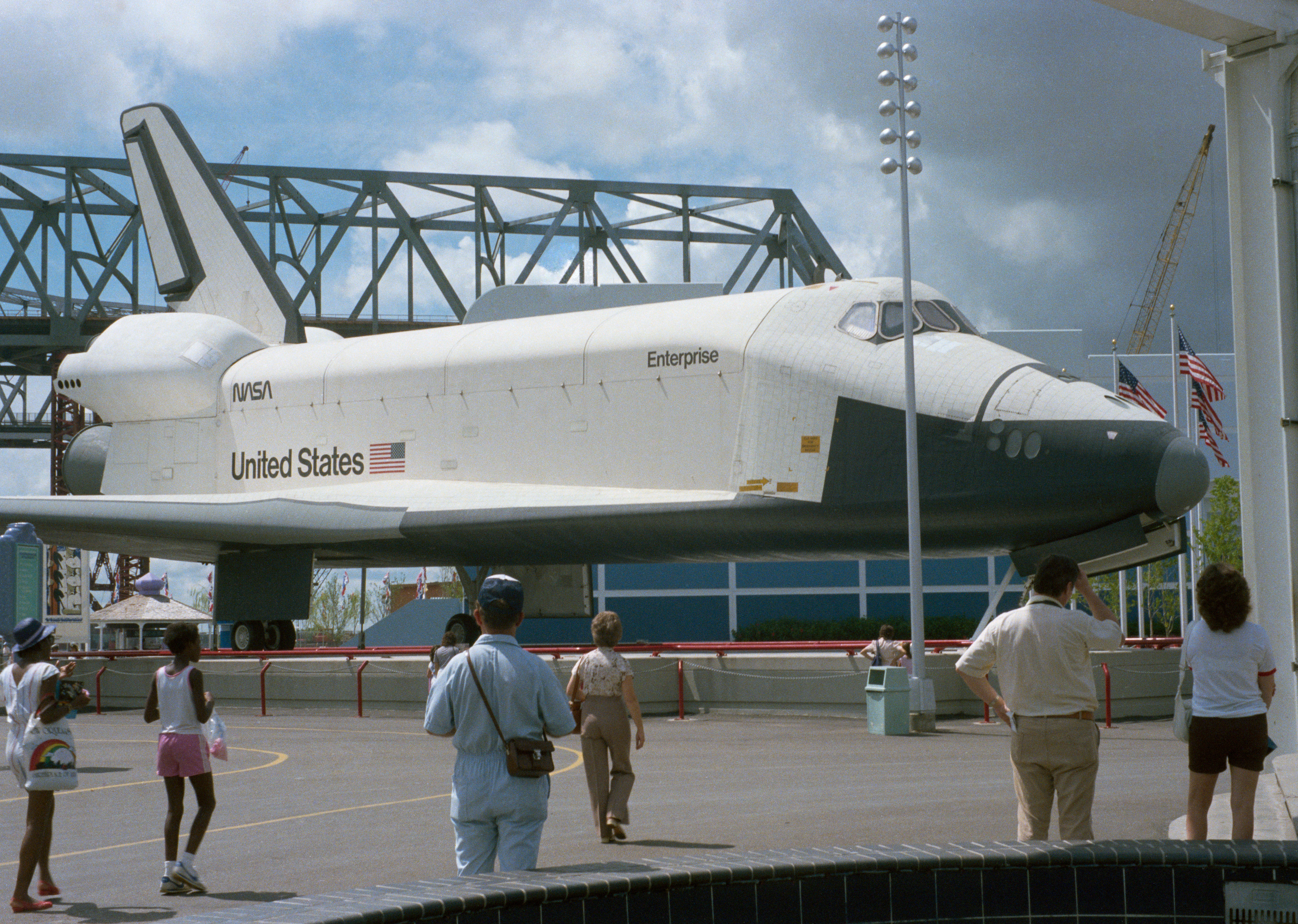
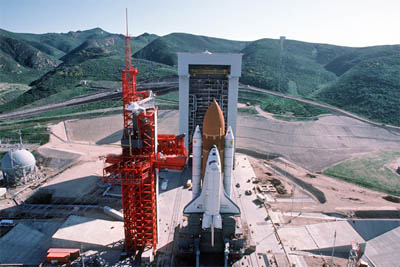
Left: Enterprise on display at the World’s Fair in New Orleans in 1984. Right: Enterprise during static pad tests at Space Launch Complex-6 at Vandenberg Air Force Base in 1985.
On Sep. 20, 1985, NASA ferried Enterprise to KSC and placed it on temporary public display near the VAB, next to the Saturn V already displayed there. On Oct. 30, Enterprise “saw” its sister ship Challenger fly into space on the STS-61A mission. After two months on display at KSC, NASA flew Enterprise to Dulles International Airport outside Washington, D.C., arriving on Nov. 18. NASA officially retired Enterprise and transferred ownership to the Smithsonian Institution that had plans to build a large aircraft museum annex at the airport. The Smithsonian placed Enterprise in storage in a hangar, awaiting the completion of its new home. That turned into an 18-year wait.
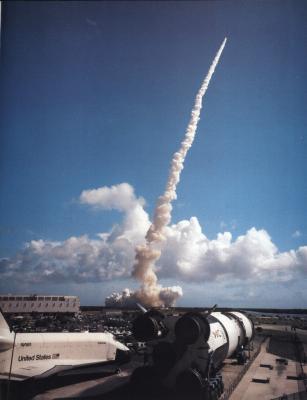

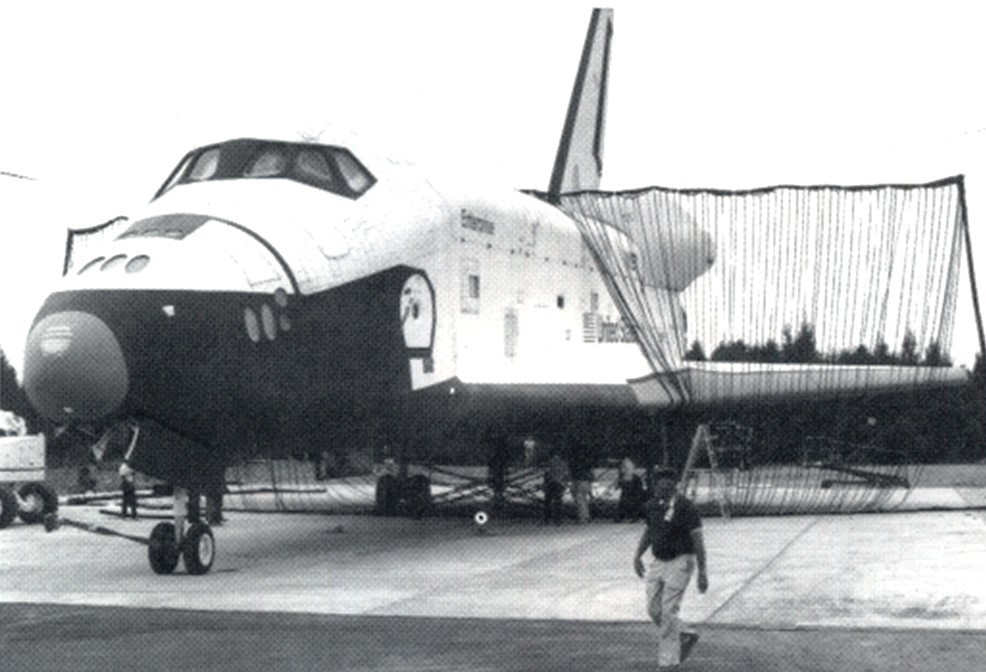
Left: Launch of STS-61A in October 1985, with Enterprise and the Saturn V in the foreground. Middle: Enterprise in long-term storage at the Stephen F. Udvar-Hazy Center of the Smithsonian Institution’s National Air and Space Museum in Chantilly, Virginia. Right: Enterprise during arresting barrier testing at Dulles International Airport.
But even during that 18-year wait, NASA found practical use for the venerable Enterprise. In 1987, the agency studied how to handle an orbiter returning from space should it suffer a brake failure. To test the efficacy of an arresting barrier, workers slowly winched Enterprise into a landing barrier they had set up at Dulles to see if the vehicle suffered any damage. Later that same year, NASA used Enterprise to test various crew bailout procedures being developed in the wake of the Challenger accident. In 1990, experimenters used Enterprise’s cockpit windows to test mount an antenna for the Shuttle Amateur Radio Experiment, with no other orbiters available. Periodically, engineers removed parts from Enterprise to test for materials durability, and also evaluated the structural integrity of the vehicle including its payload bay doors and found it to be in sound condition even after years in storage. In April 2003, in the wake of the Columbia accident, investigators borrowed Enterprise’s left landing gear door and part of the port wing for foam impact tests. The tests provided solid evidence for the foam strike as the cause of the accident.
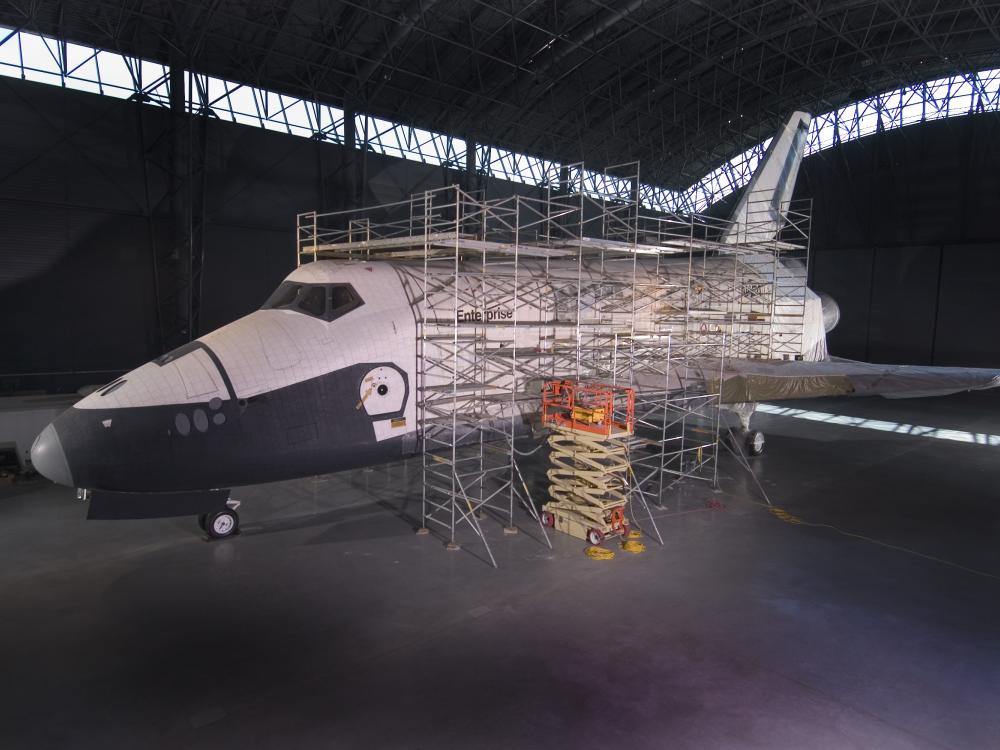
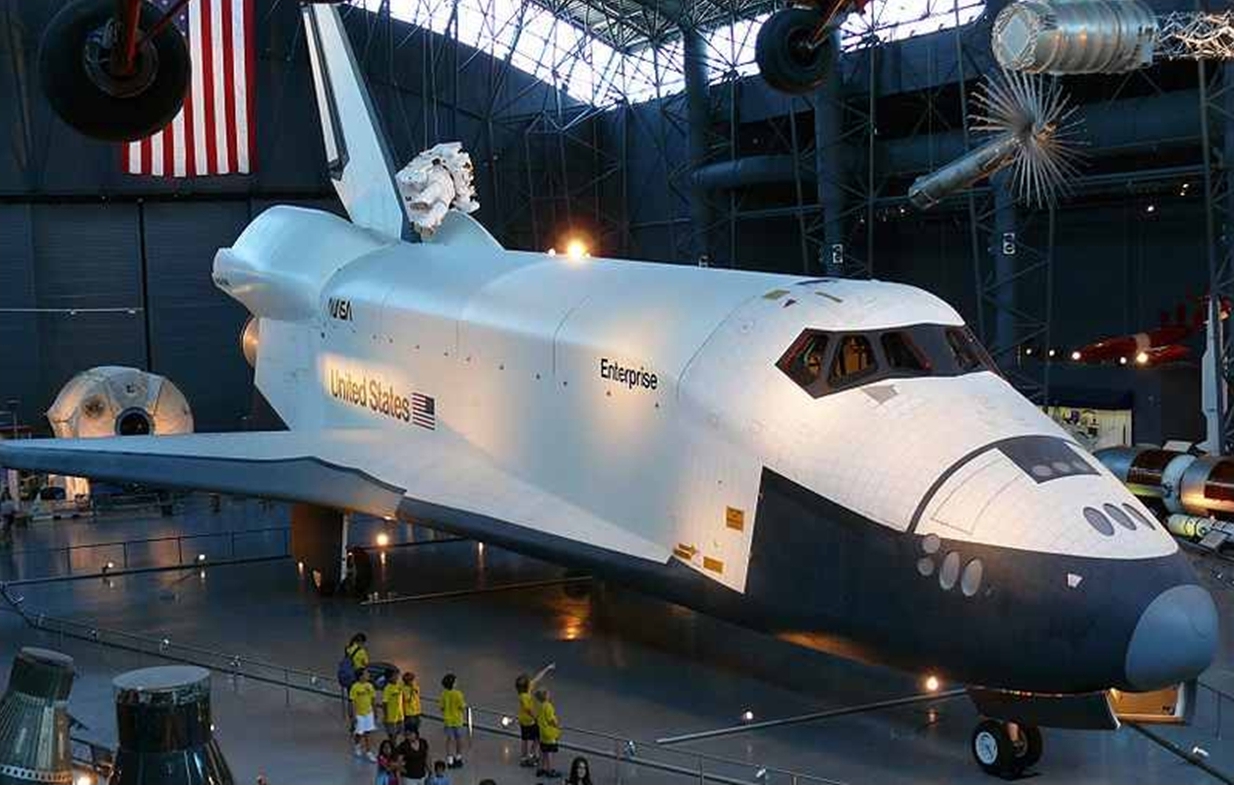
Left: Space shuttle Enterprise undergoes restoration at the Stephen F. Udvar-Hazy Center of the Smithsonian Institution’s National Air and Space Museum (NASM) in Chantilly, Virginia. Note the missing wing leading edge, donated for the Columbia accident investigation. Right: Enterprise on display at the Hazy Center. Image credits: courtesy NASM.
On Nov. 20, 2003, workers towed Enterprise from its storage facility into a newly completed display hangar at the Stephen F. Udvar-Hazy Center of the Smithsonian Institution’s National Air and Space Museum at Dulles in Chantilly, Virginia. Specialists spent eight months restoring the orbiter and the museum placed it on public display on Dec. 15, 2004.
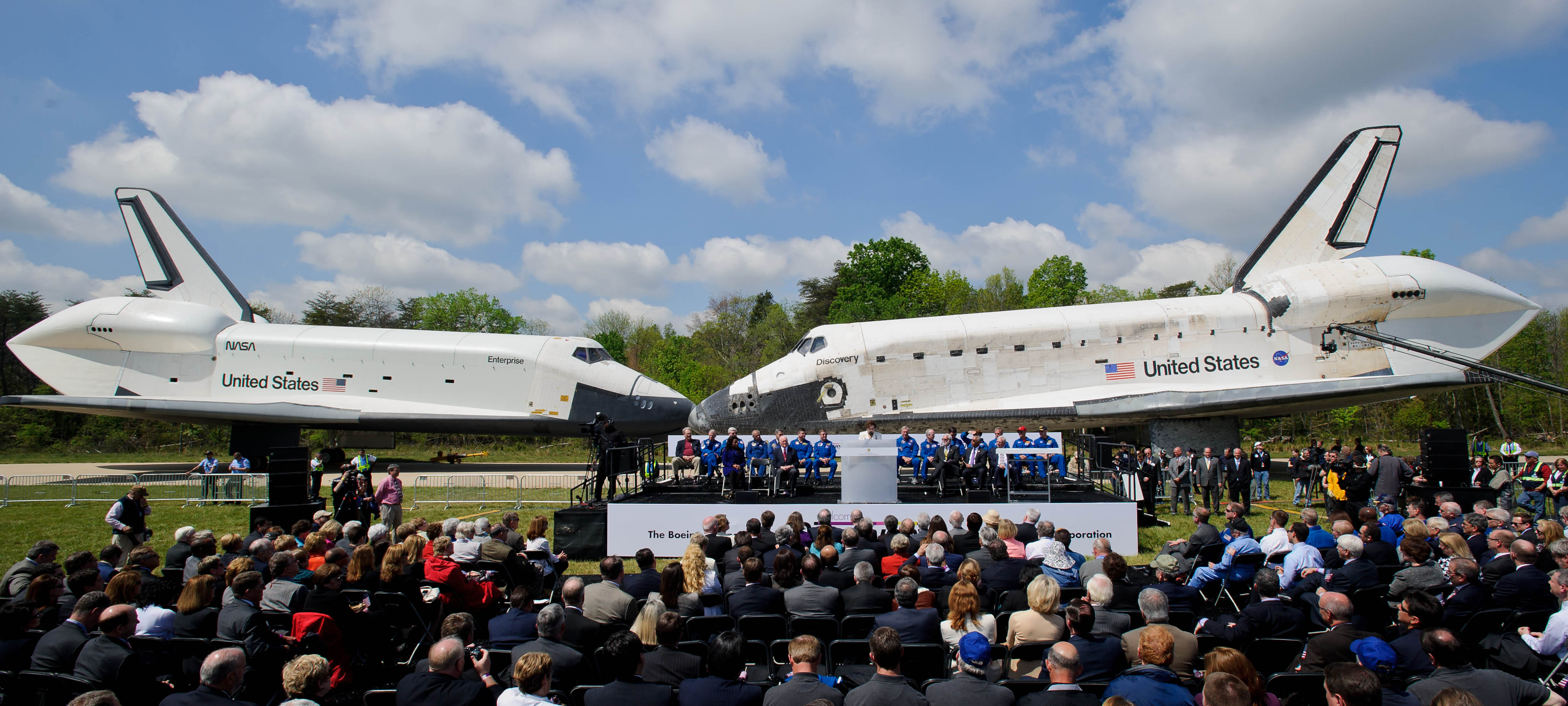
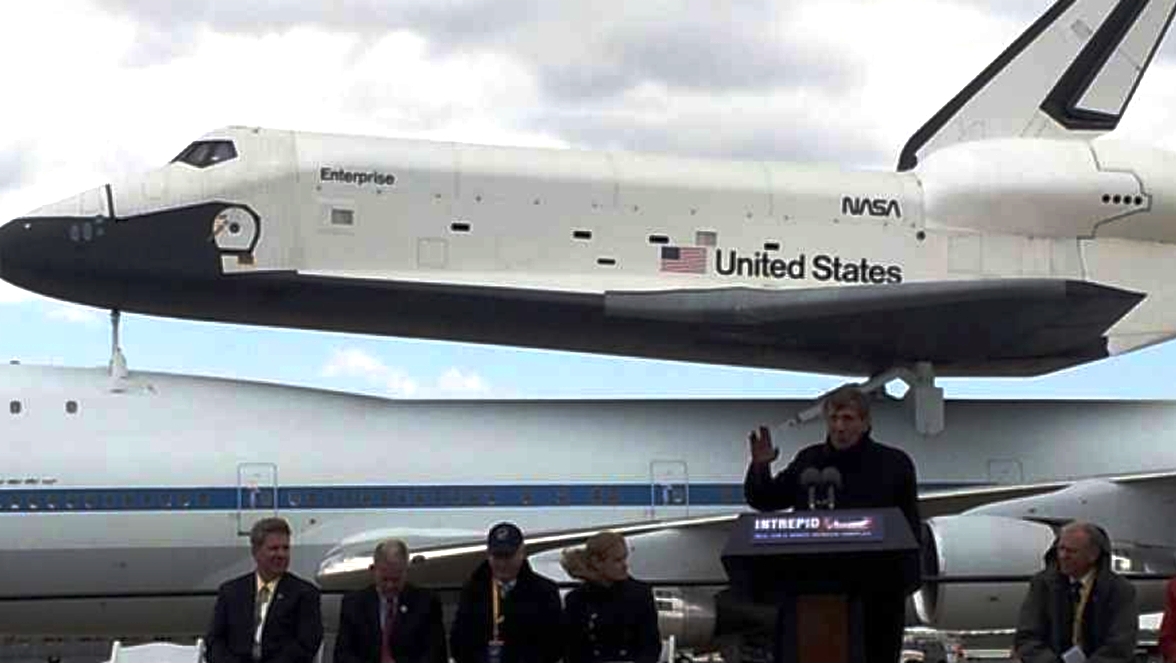
Left: Space shuttle orbiters Enterprise, left, and Discovery meet nose-to-nose at the Stephen F. Udvar-Hazy Center of the Smithsonian Institution’s National Air and Space Museum in Chantilly, Virginia. Right: Actor Leonard Nimoy greets Enterprise at John F. Kennedy International Airport in New York City.
In 2011, NASA retired the space shuttle fleet and donated the vehicles to various museums around the country. The Intrepid Sea, Air & Space Museum in New York City acquired Enterprise, and on Apr. 19, 2012, workers removed the orbiter from its display at the Hazy Center – replacing it with the orbiter Discovery – and placed it atop a SCA for the final time. Eight days later, after a short flight from Dulles and a flyaround of New York and several of its famous landmarks, Enterprise landed at John F. Kennedy International Airport. Actor Leonard Nimoy, who played Mr. Spock in the original “Star Trek” television series, and attended Enterprise’s first rollout in 1976, greeted the orbiter on the runway. Workers lifted the orbiter from the SCA and placed it on a barge. It eventually arrived at the Intrepid Museum on June 3 and went on public display July 19. Enterprise suffered minor damage during Superstorm Sandy in October 2012, but workers fully restored it.

Enterprise in the Shuttle Pavilion at the Intrepid Sea, Air & Space Museum in New York City. Image credit: courtesy Intrepid Museum.
Read recollections about the Enterprise ALT flight in oral histories that Haise, Fullerton, and Engle conducted with the JSC History Office.
What's Your Reaction?



















.jpg?#)























